

Language Arts by bonnie prisayane on Prezi. Inclusion in Early Childhood Programs: Children with Exceptionalies. Quality Indicators of Inclusive Early Childhood Programs/Practices. Chapter 19 - Inclusion in Early Childhood Programs: Children with Exceptionalities. Early Childhood Inclusion. Rethinking Early Childhood Education. Inspired by 'The Language of Art' (Ann Pelo) Vygotsky. Piaget & Vygotsky in 90 seconds. College of Early Childhood Educators Ontario. Early Learning for Every Child Today (ELECT) Code of Ethics and Standards of Practice. Lisson Gallery. The activities of Art & Language have been marked from the outset by practical variety, by resistance to easy categorisation and by a tendency to provoke open and reflexive enquiry.
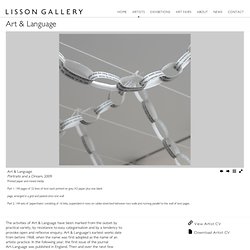
Art & Language’s earliest works date from before 1968, when the name was first adopted as the name of an artistic practice. In the following year, the first issue of the journal Art-Language was published in England. Then and over the next few years Art & Language provided a common identity for a number of people already involved in various types of collaboration. The mid 1960s had seen widespread collapse in the authority of those individualistic cultural protocols which go under the name of Modernism, and the coming together of the two terms ‘Art’ and ‘Language’ served to recognise a range of intellectual concerns and artistic expedients which that collapse had occasioned.
Language Arts. Ideal World. The Official Eric Carle Web Site. Carle Museum. The Official Eric Carle Web Site - Caterpillar Exchange Bulletin Board. This is a bulletin board where teachers and parents using Eric Carle’s books in creative ways can submit their ideas.

We have heard from a number of enthusiastic teachers, parents, librarians, booksellers and children about the programs that are being taught using Eric Carle’s books as the focus or as the starting point. Some are reading and writing projects, some are science and math projects, some are art projects, and some projects combine all sorts of activities. We hear from prekindergarten care givers and we hear from 5th grade art teachers. The ideas and opinions expressed here are solely the responsibility of the person submitting the entry and not necessarily that of Eric Carle.
We reserve the right to not post an entry if we deem it to be inappropriate in any way. Ideas have been submitted for the following Eric Carle books, however feel free to submit ideas for books that are not listed. Using Art to Enhance Major Areas of Development. Educational articles are an excellent resource for parents who are interested in learning about the best parenting practices from experts in the field.
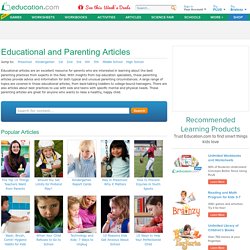
With insights from top education specialists, these parenting articles provide advice and information for both typical and unusual parenting circumstances. A large range of topics are covered in these educational articles, from back-talking toddlers to college-bound teenagers. There are also articles about best practices to use with kids and teens with specific mental and physical needs. These parenting articles are great for anyone who wants to raise a healthy, happy child.
Popular Articles. LANGUAGE DEVELOPMENT THROUGH ART. Art activities are excellent opportunities for encouraging language development.
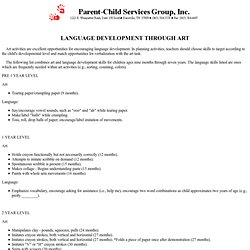
In planning activities, teachers should choose skills to target according to the child's developmental level and match opportunities for verbalization with the art task. The following list combines art and language development skills for children ages nine months through seven years. The language skills listed are ones which are frequently needed within art activities (e.g., sorting, counting, colors). Art: Tearing paper/crumpling paper (9 months). Language: Say/encourage vowel sounds, such as "ooo" and "ah" while tearing paper. Holds crayon functionally but not necessarily correctly (12 months). Emphasize vocabulary, encourage asking for assistance (i.e., help me), encourage two word combinations as child approximates two years of age (e.g., pretty ________).
The Arts: Promoting Language & Literacy of Young Children. Louise J.
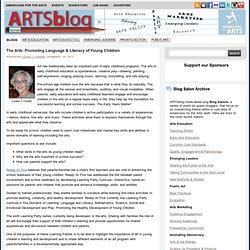
Corwin Art has traditionally been an important part of early childhood programs. The arts in early childhood education is spontaneous, creative play—drawing, painting, self-expression, singing, playing music, dancing, storytelling, and role playing. Pre-school age children love the arts because that is what they do naturally. The arts engage all the senses and kinesthetic, auditory, and visual modalities.
Global Children's Art Programme. Language Art Activities for Young Preschoolers. How Arts and Crafts Help Develop Language in Young Children. "SPRING BOUQUET" - AN EASY-ART PICKING FLOWERS CRAFTIVITY. <div class="deployment_message_block"><span> Hi, You need to enable javascript on your browser to use TpT.
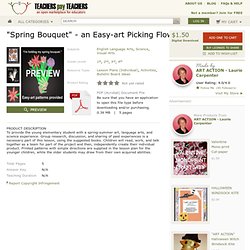
<a href=" target="_blank">See how this improves your TpT experience</a>. </span></div> ABOUT US | BLOG | FAQs & HELP Not a member? Join for FREE Your shopping cart is empty "Spring Bouquet" - an Easy-art Picking Flowers Craftivity Subjects English Language Arts, Science, Visual Arts Grade Levels 1st, 2nd, 3rd, 4th Resource Types Lesson Plans (Individual), Activities, Bulletin Board Ideas Product Rating Not yet rated PDF (Acrobat) Document File Be sure that you have an application to open this file type before downloading and/or purchasing. 0.39 MB | 5 pages.
How Young Children Learn Language. In the early childhood classroom, silence is not golden.
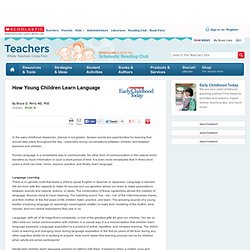
Spoken words are opportunities for learning that should take place throughout the day - especially during conversations between children and between teachers and children. Human language is a remarkable way to communicate. No other form of communication in the natural world transfers so much information in such a short period of time. It is even more remarkable that in three short years a child can hear, mimic, explore, practice, and finally, learn language. Language LearningThere is no genetic code that leads a child to speak English or Spanish or Japanese. Integrating Thinking, Art and Language in Teaching Young Children, International Education, 2009. This study investigates learning outcomes of four-year-old children at a preschool in P.
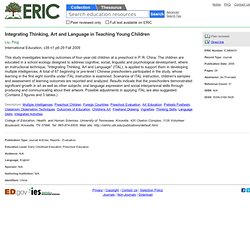
R. China. The children are educated in a school ecology designed to address cognitive, social, linguistic and psychological development, where an instructional technique, "Integrating Thinking, Art and Language" (ITAL), is applied to support them in developing multiple intelligences. A total of 67 beginning or pre-level I Chinese preschoolers participated in the study, whose learning in the first eight months under ITAL instruction is examined.